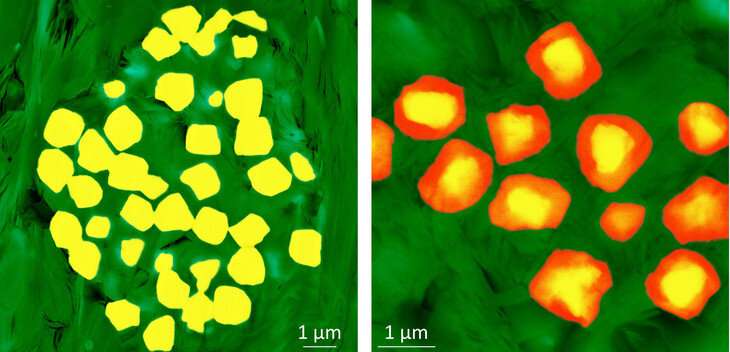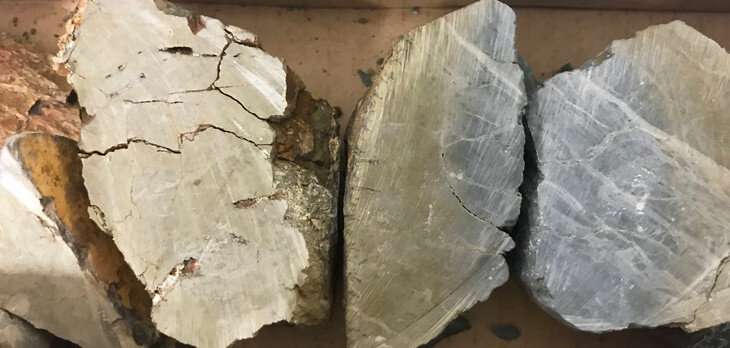Landscape to atomic scales: Researchers apply new approach to pyrite oxidation

Pyrite, or fool's gold, is a common mineral that reacts quickly with oxygen when exposed to water or air, such as during mining operations, and can lead to acid mine drainage. Little is known, however, about the oxidation of pyrite in unmined rock deep underground.
A new, multi-scale approach to studying pyrite oxidation deep underground suggests that fracturing and erosion at the surface set the pace of oxidation, which, when it occurs slowly, avoids runaway acidity and instead leaves behind iron oxide "fossils."
"Pyrite oxidation is a classic geologic and environmental problem, but we know little about the rate of pyrite oxidation occurring in deep rock," said Xin Gu, assistant research professor in Penn State's Earth and Environmental Systems Institute (EESI). "When pyrite reacts with oxygen, it releases sulfuric acid, which can cause acid mine drainage, a serious environmental problem across the globe and especially here in Pennsylvania."
When exposed to air, like in a mine, pyrite will fully oxidize in a matter of years, Gu said. Microorganisms can also form on the mineral and speed up the reaction. The oxidation process happens quickly and allows sulfuric acid to accumulate. However, if left unmined deep below the surface, geologic processes slow the reaction by tens of thousands of years and prevent the acid from accumulating.
The researchers studied pyrite oxidation at the National Science Foundation-funded Susquehanna Shale Hills Critical Zone Observatory (CZO). The Shale Hills CZO is a forested research site in Penn State's Stone Valley Forest that sits atop a shale formation, one of the most common rock types in the world. The researchers lowered geophysical logging tools—instruments that can send and receive signals, or even take high-resolution images—down boreholes 3-inches wide and recovered rocks from more than 100-feet deep to examine the shale bedrock and identify how deep or shallow pyrite weathers and fractures underground.
The team studied grains of pyrite and how they turn into rust-type iron oxides using specialized microscopes in Penn State's Material Characterization Laboratory. They cut the rock into slices less than one-tenth of an inch thick and placed the sections under scanning electron microscopes to image their microstructures. High-resolution transmission electron microscopes, which use beams of electrons to produce images, helped the researchers study the microstructures down to small features about 70 times thinner than a human hair.
Examining the samples allowed the researchers to identify the zone underground where pyrite oxidizes to a rust-type iron mineral at a very fine scale, Gu said.

The researchers reported their findings in a recent issue of Science.
The team found that the erosion rate of the shale controlled the rate of pyrite oxidation at depth. Microscopic fissures that form in the rock tens of feet below the surface are too small for microorganisms to enter. In landscapes like Pennsylvania's that erode over millennia, oxygen dissolved in water seeps into the openings and has plenty of time to catalyze the reaction, doing so in small quantities. When this occurs, the pyrite pseudomorphs, meaning that structurally it retains its raspberry-like shape even though chemically it has transformed from iron sulfide to iron oxide.
"The quantity and speed at which the reaction occurs underground explains why pyrite is replaced by these perfect iron oxide 'fossils,'" said Susan Brantley, distinguished professor of geosciences and director of EESI.
The researchers used their findings to develop a model to calculate pyrite oxidation rates at Shale Hills and across the globe, including in areas with faster erosion rates. It can also help scientists better understand what Earth was like before the Great Oxidation Event 2.4 billion years ago, which allowed more complex organisms to grow and evolve.
"What Xin did is extraordinary," Brantley said. "He showed that pyrite oxidizes 30 feet or more beneath the land surface to form crystals that are perfect replicas of the original pyrite grain. He also showed that this deeper understanding of pyrite can reveal information about why pyrite was still preserved at the land surface on the early Earth, when oxygen was present at lower concentrations in the atmosphere."
The Shale Hills Critical Zone Observatory is the best place to conduct this type of work, according to Gu.
"We have experts from diverse fields who are working on different aspects of this watershed, like hydrology, erosion, soils, biota and weathering profiles," he said. "If we conducted the study at one scale or from one disciplinary perspective, we would have missed a large part of the story. Our interdisciplinary approach allows us to better understand what is happening here."
More information: Xin Gu et al. Deep abiotic weathering of pyrite, Science (2020). DOI: 10.1126/science.abb8092
Journal information: Science
Provided by Pennsylvania State University




















